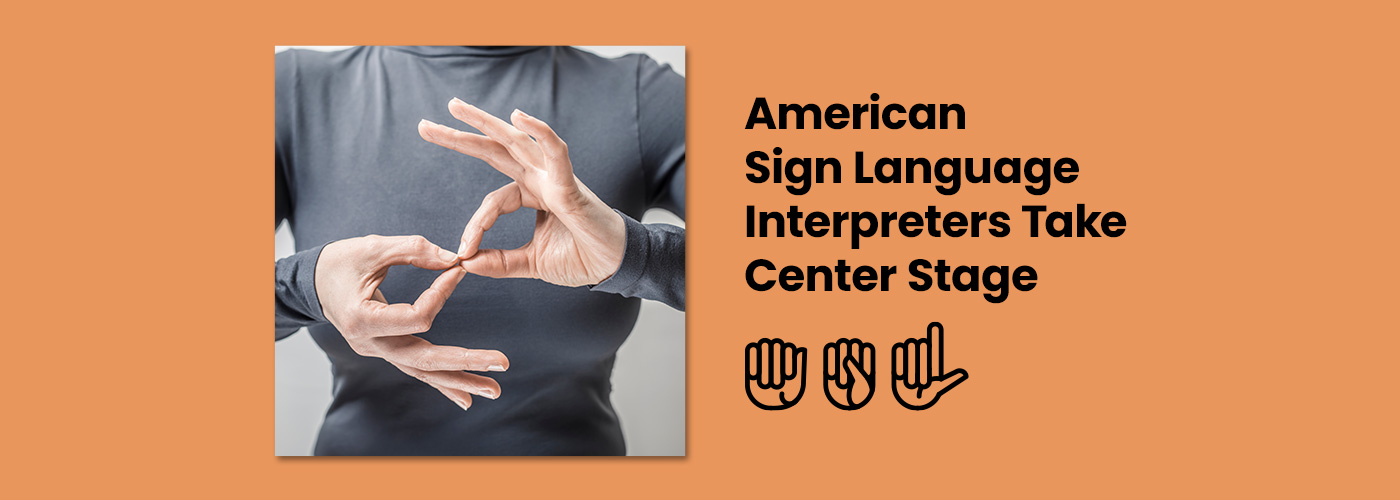American Sign Language interpreters take center stage

“I am bilingual – ASL is my first language. I was using ASL before I ever learned English, which didn’t happen until I was in kindergarten.”
Jayne Tubergen has dedicated her career as an American Sign Language interpreter to opening a world of communication for people who are deaf. ASL is a visual language that includes signs, gestures, facial expressions, and body language. Both of Tubergen’s parents are deaf. Like many others who are deaf, they use ASL to communicate. She interpreted for them throughout her childhood and before receiving a college degree in deaf education.
Tubergen was not inclined to follow the typical teacher classroom routines, so she put her degree to use and taught for a year at the Model Secondary School for the Deaf in Washington, D.C. For the next 38 years, her work as an American Sign Language interpreter continued. “I have had too much fun as an interpreter and enjoy the fact that every opportunity to interpret brings something new, something novel to my life.”
Like Tubergen, Kelly Corbey also owns and operates an ASL interpretation company. Both have been supporting SourceAmerica® employees who use ASL for the last 15 years. “I have a passion for working with people with disabilities. Supporting the SourceAmerica mission has a very special place in my heart,” said Corbey.
Corbey says interpreters are present for both deaf and hearing (non-signing) participants. In order to be effective, she says interpreters do not participate or offer their opinions. Their role is to use ASL to communicate what is being said by the hearing participant and voice what is being signed by the deaf participant. “An ASL interpreter provides the communication for the deaf community to have access to the same information, jobs, or collaborative opportunities. ASL interpreters are communications facilitators.”
Corbey’s path to becoming an interpreter came out of a powerful experience that she had in her childhood. As a teen, her parents were out for a walk when they came across a summer camp for kids with disabilities. They suggested that Corbey and her siblings volunteer there.
The volunteer experience opened a new way of thinking. “The kids with disabilities were really no different than I was,” she recalled. In working with some of the campers, Corbey began to learn some of her first ASL signs.
A leader of the federal Workforce Recruitment Program had a child attending that camp. That program helps connect college students and recent graduates with disabilities to employers. “He saw me interacting with the campers and noticed that I had a distinct level of comfort when I was working with the kids,” she said. “He asked me to work in the Workforce Recruitment Program and I took him up on the offer. I took that experience and it eventually led to my career.”
Worldwide changes due to COVID-19 shined a spotlight on ASL interpreters, with expanded telework options and associated technology. “Zoom and other videoconferencing programs have been very helpful for interpreters,” said Corbey. “On phone calls, it’s hard for an interpreter to know who is talking, but programs like Zoom and the option to highlight the speaker on screen is very helpful. It’s taken one barrier away for us and has been a blessing during this increased phase of teleworking.”
“Videoconferencing has given me the added bonus of not being limited by geography. I can work across the globe now,” added Tubergen. “ASL opens doors and opportunities for people who are deaf, as well as for the organizations and companies they work for. ASL is the native language for many deaf people in the U.S. SourceAmerica’s efforts to create job opportunities for people with disabilities satisfies my own need to make sure that capable and qualified people are not denied opportunities that they deserve.”